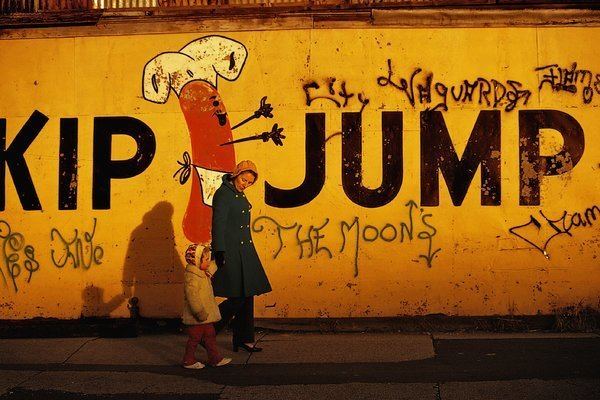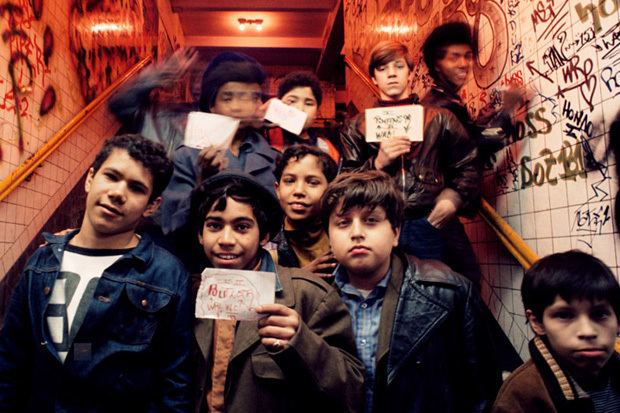Nationality American Occupation Photographer, Author | Name Jon Naar Role Author | |
 | ||
Books The Birth of Graffiti, Design for a livable planet | ||
Getting the picture the photography of jon naar
Jon Naar is a British-American author and photographer celebrated for his pioneering images of New York City graffiti in the 1970s. Still active in his nineties, Naar has had a multifaceted career as an intelligence officer in World War II; a globe-trotting executive during the postwar years; and an environmentalist, with nine published books to date.
Contents
- Getting the picture the photography of jon naar
- Jon Naar Photographer
- Career
- Major exhibitions
- Published works
- References

Jon Naar, Photographer
Career
Born in London in 1920, Naar graduated at 15 from the private Mill Hill School. Too young to attend an English university, he crossed the Channel to study French and German at the Sorbonne. At this point, Naar had yet to develop a special interest in photography, but his artistic and design sensibilities were being shaped by his Parisian influences, particularly the street photographs of Brassaï. Four years later, his matriculation at the University of London cut short by the outbreak of World War II, Naar was conscripted. Thanks to prior experience in the Officers' Training Corps at Mill Hill, he would spend the next six years on intelligence work, including service with the British Special Operations Executive, on clandestine assignments that took him through the Middle East and Italy. At war's end, by-then Major Naar emigrated to New York City and secured American citizenship.

Over the next decade and a half, Naar's business career advanced. A stint of writing on biological science issues led Naar first to the public relations offices at Columbia-Presbyterian Hospital, then to a position as managing editor of the World Wide Medical News service, a division of advertising agency William Douglas McAdams. From 1957, he directed international marketing for Pharmacraft Laboratories, a division of Seagram Corporation. Through the 1950s, armed with a Super Ikonta rangefinder camera and later a Praktica single-lens reflex, Naar was developing his eye as a "weekend" photographer, roving his Greenwich Village neighborhood and seeking out subject matter while on foreign corporate assignments.

It was not until Naar's early forties, after influential photographers Nickolas Muray and André Kertész—both impressed by his hobbyist portfolio—offered encouragement, that he resolved to seek wider exposure as a photographer. A series of street scenes Naar shot in Mexico City in 1962 was featured in a 1963 solo exhibition in Coyoacan titled "El Ojo de un Estranjero." His 23-page photo essay on Germany, 20 years after the death of Adolph Hitler, appeared in the Italian design magazine Domus. New York Times critic Joseph Deschin, reviewing Naar's 1965 one-man show at New York University's Loeb Student Center, extolled his "flair for design and an eye for the unexpected ... his pictures generate the kind of excitement that one associates with discovery of newness in the familiar." The striking image "Shadows of Children on Swings" was selected by Ivan Dmitri for the Metropolitan Museum's "Photography in the Fine Arts" exhibition, and for its permanent collection. Within the span of a few years, Naar had not only transformed himself into a professional photographer, but was in demand as a contributor to major publications like The New York Times, The Saturday Evening Post, Vogue, Fortune, Elle, and Schöner Wohnen.
If Naar had a specialty at that time, it was photographing artists and architects amidst their creative (and created) surroundings. One of his earliest and most enduring images featured a young Andy Warhol sprawled on a red plush sofa, surrounded by glistening objects in the infamous "Silver Factory." Other subjects over the years included Luis Barragán, Marcel Breuer, Christo, Alexander Liberman, Heinz Mack, Marino Marini, Henry Moore, Barnett Newman, Saul Steinberg, and Günther Uecker. His portrait of Josef Albers accompanied that artist's obituary in the New York Times.
By the 1970s, Naar's reputation was well established and he was redirecting his energies toward on-location corporate work for a diverse range of clients. Then in 1972, a commission for the London-based design firm Pentagram morphed into a full-length book project, with the 1974 release of The Faith of Graffiti (UK title Watching My Name Go By)—the first book-length examination of New York City graffiti art. Featuring an introduction by novelist Norman Mailer, the controversial collection would become "like a bible to later graffiti artists," in the words of Brian Wallis, chief curator at New York's International Center of Photography. Naar "legitimized" graffiti "a decade earlier than anyone else, and he came at it with a graphic design sensibility—he understood color and composition and bold design." It is for this groundbreaking series that Naar himself remains in demand, with numerous recent retrospectives and a 2007 collection, The Birth of Graffiti, which includes 130 previously unpublished photographs from the original assignment.
Other book projects followed, providing Naar with an opportunity to return to researching and writing on scientific topics, especially environmental themes. Jacques Cousteau wrote the introduction to Naar's 1973 book, Design for a Limited Planet, which featured interviews and photographs with pioneers of solar energy in the American Southwest and sold over 100,000 copies. As an early advocate of solar energy—he helped mount the first solar collectors on the roof of the White House—Naar later became president of the New York Metropolitan Solar Energy Society, and served for two years (1996-1998) as deputy director of renewable energy programs at the United States Agency for International Development. As a consultant, he worked with entities such as NRDC (Natural Resources Defense Council) and SELCO (Solar Electric Light Company India). In 1991, the American Library Association included Design for a Livable Planet (coauthored by Naar and his son Alex) among its "Best Books of the Year for Young Adults". His 2005 survey collection, Getting the Picture, was included in the "Best Designed Books 2006" exhibition at the Stedelijk Museum, Amsterdam.
Since 2000, Naar has resided in Trenton, New Jersey. In 2013, the New Jersey State Museum mounted an exhibition of his old and new work, entitled "Jon Naar: Signature Photography."
